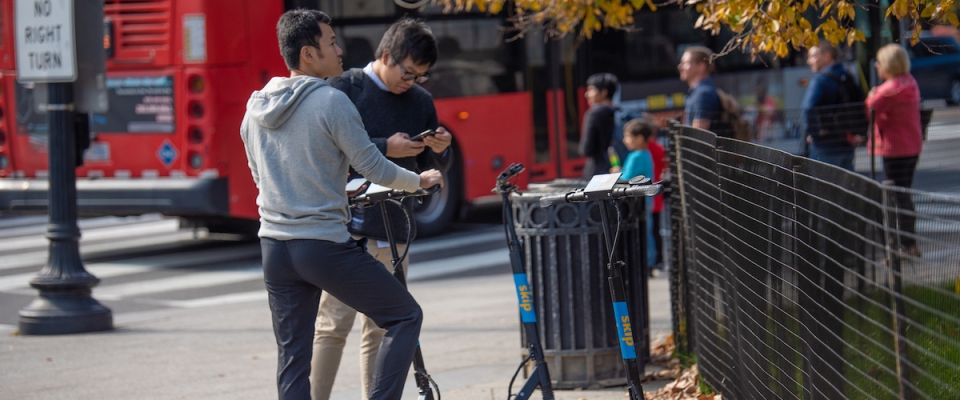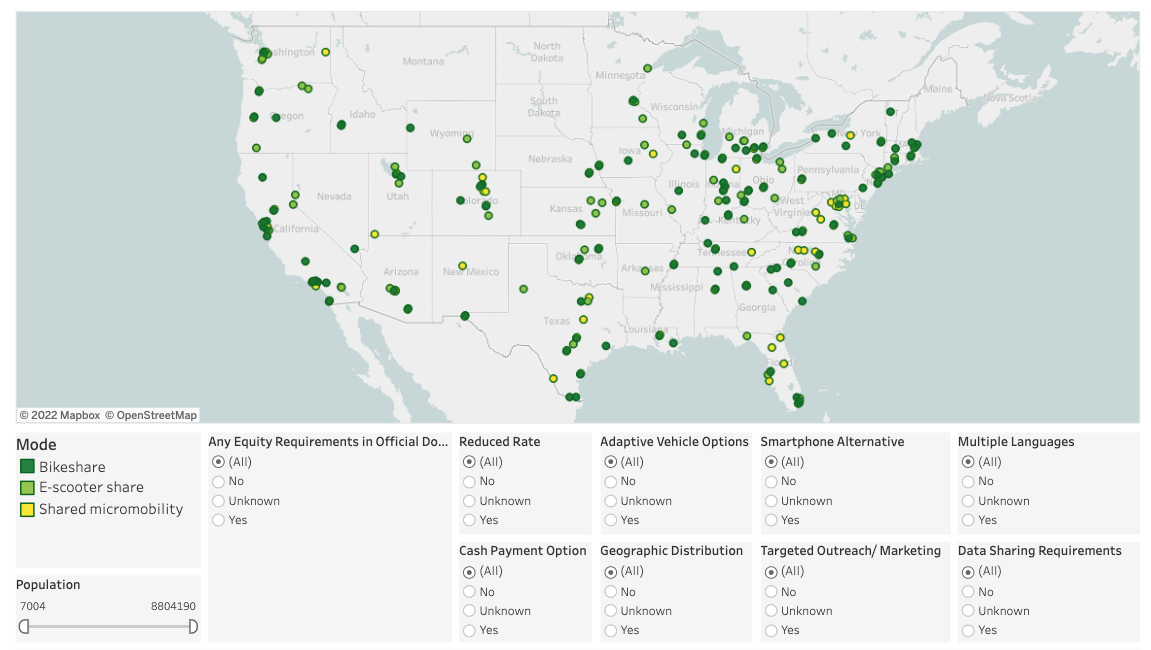New Tools Can Operationalize Equity in 239 E-Scooter and Bike Share Programs Across the U.S.

Shared micromobility programs for e-scooters and bike share are becoming more common each year. How can we make sure they aren’t just being used for fun, but they’re also being prioritized for those who need a quick, affordable and accessible way to get around? A team of researchers has collected documentation about equity requirements from 239 shared micromobility programs across the U.S. and compiled all the data into an online dashboard, which city officials can use to find what other similar-sized cities are doing. Equity efforts in one city may pave the way for expanded opportunities in another.
Keeping a focus on equity can make this new technology accessible and affordable, and could improve the lives of people with disabilities, people with low incomes, those who don't have access to a smartphone, and those who live in neighborhoods without good transit access. Led by the University of Oregon's Anne Brown and Amanda Howell, with Hana Creger of The Greenlining Institute, the latest report from the National Institute for Transportation and Communities (NITC) took steps toward operationalizing equity in these programs: In other words, making it simple for cities, agencies and mobility providers to ensure their e-scooter and bike share programs serve the communities who most need them.
"Our hope is, for companies or cities that are starting a new program, they can use the dashboard and find specific language for equity requirements in other comparable cities. Micromobility companies are now going to smaller communities, but their staff often don't have the bandwidth to study in depth what other places are doing," Brown said.
Screenshot of the equity dashboard: a United States map with dots representing the shared micromobility programs surveyed in the study. Filters below the map let the user sort the programs by various criteria.
Filters in the dashboard let the user sort by mode, city population size, and specific program requirements. Rather than reinvent the wheel, cities looking to introduce a new program or rethink their existing micromobility service can quickly scan the dashboard and get detailed information about reduced fare programs, geographical distribution, adaptive vehicles, cash payment options, smartphone alternatives, targeted marketing and outreach, and multilingual services.
The researchers also created a Shared Micromobility Equity Evaluation Tool, which lets equity program managers see their equity "score" in three key areas: process, implementation, and evaluation.
Related research: Breaking Barriers to Bike Share. In a 2018 NITC study, researchers from Portland State University and the Better Bike Share Partnership evaluated equity programs in bike share systems. In 2020, they released ten equity briefs to guide bike share system operators. This new study from UO study builds upon this work by expanding the number of systems studied from around 70 to 239; including e-scooters along with bike share; and compiling a wealth of regulatory language and tools for cities and agencies to draw from.
SO WHAT ARE CITIES DOING FOR EQUITY, AS OF NOW?
Researchers found that equity requirements were common, but far from universal. Of the 239 programs they studied, 149 of them (about 62%) had requirements related to equity. Other cities and agencies had language recommending, encouraging, or stating that equity-based program elements were desirable, but did not require that operators implement them.
The most prevalent equity requirements, across both bike share and e-scooter programs, were those targeting implementation equity as described in the graphic above, with process and evaluation requirements being less common. In the area of implementation equity, cities most commonly include requirements related to technology access, such as requiring smartphone-alternative access (found in 35% of programs), cash payment options (33%), and a reduced fare option (32%).
The least common requirement, found in just 5% of programs, was the requirement to include adaptive vehicles for people with disabilities.
Equity requirements were found to be more common among e-scooter programs than bikeshare, although joint micromobility programs (e-scooter plus bikeshare) were most likely to have equity requirements. Most cities and agencies that enact equity requirements focus on expanding access to shared micromobility services; fewer evaluate shared micromobility outcomes.
"Unfortunately, there is still a disconnect between goals, implementation, and outcomes. For example, cities want to expand access, so they will have a reduced fare requirement, but then they are not really collecting data to understand utilization of these programs. So, how effective are these programs? This is a question that's still very difficult to answer, because most places are not collecting the data they need to answer those questions," Howell said.
HOW CAN CITIES TAKE MICROMOBILITY EQUITY FURTHER?
Cities and agencies vary greatly in their approach to advancing equity in shared micromobility programs. The research team identified some promising approaches, including:
- Link operational incentives to desired equity outcomes: It helps to ensure that there is a clear arc connecting specific goals with program requirements.
- Dedicate staff time and resources to manage shared micromobility programs: cities with staff dedicated to promoting equity in shared micromobility programs are instrumental in operationalizing robust equity offerings.
- Match each program requirement with targeted data collection: Data are needed to enable assessment of how successfully each requirement is meeting its goals.
- Conduct transparent evaluations: Clear evaluations will help measure progress and identify future paths of improvement or iteration.
- Define program goals and agree on a shared definition of equity: Cities, regardless of the robustness of their city or program-level goals, should bolster the connections between stated micromobility program goals, required equity components, and collected data.
- Move towards a model of community empowerment: By and large, cities and agencies surveyed in this project did not conduct mobility needs assessments prior to launching a shared micromobility program. These assessments help identify and understand unmet needs in the community, and develop solutions in partnership with those community members. An assessment could determine how a micromobility program would fit within the broader context of community priorities – or even if it was a priority. Significant change is needed in how they include community input, by dedicating resources to open-ended mobility needs assessments.
Finally, cities must pair program-specific efforts with broader efforts needed to truly advance equity. Even the most accessible shared micromobility programs cannot compensate for missing infrastructure or unsafe streets. In the words of one service provider the researchers spoke with: operators "can bring data to the table" but they "cannot provide the money or political will to make the big infrastructure changes that are needed."
Brown and Howell will present an overview of their findings, and demonstrate both online tools, in a free webinar on Sept 21, 2022.
RESEARCH TEAM
This research was led by Dr. Anne Brown, Assistant Professor in the School of Planning, Public Policy, and Management at the University of Oregon, and Amanda Howell, Researcher with the Urbanism Next Center at the University of Oregon. Research assistance was provided by Zoe Green (meet UO student in this interview) and in consultation with expertise in shared mobility equity from: Hana Creger (The Greenlining Institute), Duncan Hwang (APANO), Río Oxas (RAHOK), and Clarrissa Cabansagan.
ABOUT THE PROJECT
- Download the Final Report (PDF)
- Download the Project Brief (PDF)
- Online Tool: US Micromobility Equity Requirements Dashboard
- Online Tool: Shared Micromobility Equity Evaluation Tool
- Register for the Sept 21 webinar
This research was funded by the National Institute for Transportation and Communities, with additional support from the Knight Foundation.
Photo by Evgenia Parajanian/iStock
RELATED RESEARCH
To learn more about this and other NITC research, sign up for our monthly research newsletter.
- National Scan of Bike Share Equity Programs
- Evaluating Efforts to Improve the Equity of Bike Share Systems
- New Mobility For All: Can Targeted Information And Incentives Help Underserved Communities Realize The Potential Of Emerging Mobility Options?
The National Institute for Transportation and Communities (NITC) is one of seven U.S. Department of Transportation national university transportation centers. NITC is a program of the Transportation Research and Education Center (TREC) at Portland State University. This PSU-led research partnership also includes the Oregon Institute of Technology, University of Arizona, University of Oregon, University of Texas at Arlington and University of Utah. We pursue our theme — improving mobility of people and goods to build strong communities — through research, education and technology transfer.


